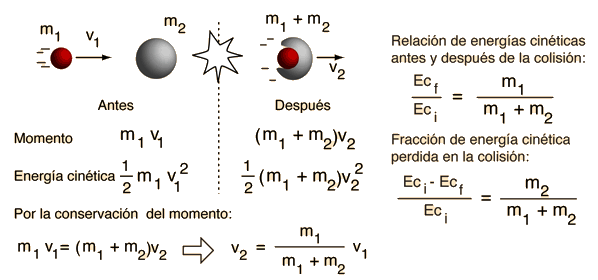The Third Law
In the definition of the Laws of Motion Newton states:
Whenever a first body exerts a force F on a second body, the second body exerts a force −F on the first body. F and −F are equal in magnitude and opposite in direction.
Later someone attempts to clarify with:
Whenever a particle A exerts a force on another particle B, B simultaneously exerts a force on A with the same magnitude in the opposite direction. The strong form of the law further postulates that these two forces act along the same line. This law is often simplified into the sentence, "To every action there is an equal and opposite reaction."
While I agree that the first statement is partially true, it is also very easy to jump to a secondary belief, that is not correct, as illustrated in the latter clarification.
Whenever a first body exerts a force F on a second body, the second body exerts a force −F on the first body. TRUE, but only with the addition of, for a split second. Then one of two things occur:
If the first body has a greater force(F) than the second body has resistance(-F), the second body will move. If the secondary body has greater resistance(-F) than the force(F) of the first body the secondary body will remain at rest.
In other words, If I am (F) the first body, and a mountain is (-F) , the second body, and I push on the mountain... it will not move. But if I(F) push against a pebble(-f), it will move. because the resistance(-f) , [the amount of force] that the pebble has is less than,(not equal to) the amount of force I am exerting on it. So the forces are opposite, but not equal, hence motion. In the time it takes for the forces to interact there is a split second where the forces are equal and opposite, but after that split second the forces are UN-equal and may or may not be opposite.
If the bodies (the two forces) act along the same line. In the case of (-F) being the greater force, the force(F) of the first body is redirected in the opposite direction, the direction of origin, and causes the first body to "bounce".
In the case of deflection, the forces are not opposite and one or both "bodies" will alter course(trajectory) based on the amounts of force applied, mass of the bodies, and velocity.
Am I Wrong?I can't quite follow what you are trying to say, or what your question is, but the forces exerted on each object will be equal, even though the result of the force to the naked eye looks different. Just think if a Ford Fiesta ran head on into a Mac truck. The Force at impact will be equal, but the reaction of the two vehicles will be disturbingly different. I think what you are trying to understand is the Conservation of Momentum. What you described, from what I can gather is an elastic case unless you are saying it loses its kinetic energy. Then it would be inelastic.
Check it out along with Newton's 3rd Law here
http://230nsc1.phy-astr.gsu.edu/hbasees/hframe.html
Click Mechanics/Conservation of MomentumNO it won't the force of the Mac truck will be greater and the Mac truck will continue along it's trajectory. Equal and Oppostie would mean they (both objects) would stop instantly at the precise point of impact. Of course if the third law was true, they couldn't have gotten past the intial effect to acheive motion in the first place...
Yes, it would. What you are describing is the conservation of momentum. The Force would even be the same if a mosquito flew into the windshield of the same Mac Truck. Maybe this will do a better job of explaining it for you. Remember, equal and opposite.
http://www.physicsclassroom.com/Class/N … /U2L4a.cfmWhenever a first body exerts a force F on a second body, the second body exerts a force −F on the first body. TRUE, but only with the addition of, for a split second.
Newton was wrong about the rest of it, because then one of two things occur:
If the first body has a greater force(F) than the second body has resistance(-F), the second body will move. If the secondary body has greater resistance(-F) than the force(F) of the first body the secondary body will remain at rest.
But the forces are NOT equal and opposite for anything more than the split second it takes for the greater force to overpower the lesser force
LOL, ok man whatever you say. Did you even review the conservation of momentum?
The Force= mass x acceleration (delta V/delta T)
The Force wont even become a factor until the collision, or whatever it is being exerted on. One object isn't going to randomly produce any more Force than the other. That is why you need to review the Conservation of Momentum. No, an object remains at rest unless acted upon by an outside Force. That is the First law not the third. lastly, there is no greater. If there was airplanes wouldn't fly, and cars wouldn't drive down the street. Sorry, but Newton got that right. You are mixing up the laws.
http://hyperphysics.phy-astr.gsu.edu/HB … kc.html#c2Your trying to add a secondary theory, that is not relevant to the discussion we're having. Though it is in a related field, and plays a seperate part.
My point is Newton and you are saying: if Every force is equal and opposite, then force=force and mass x acceleration is irrelivant... which obviously isn't correct, so you and Newton are wrong.I'm not adding any secondary theory.
F=ma is Newton's second Law.
We wouldn't even have a 3rd if the second wasn't there. Like I said, you are getting them mixed up. You are confusing impulse Force and the Conservation of Momentum. Lastly, it's not irrelevant if you want to know how much Force there was at the time of impact. It's very useful, and helps determine safety restraints etc..And that is my point, the second makes the latter part of the third incorrect, There IS NOT an equal and opposite reaction, there are consequences that may or may not be equal and/or opposite.
No, the second LAW proves there is a Force, and the third just explains what that Force does.
The Force is always equal and opposite.if F=MA then MA=F and if F=ma; MA=f=ma right?
then MA=ma still with me?
M=10
F=10
m=1
a=1
then your saying 10 times 10= 100 and 1 times1 =1 so 100=1?
the forces are not always equal. nor are they always opposite, what if the mosquito t-bones the Mac truck...
the third law states F=f always every single time...and is therefore WRONG.LOL, sorry but you are really confused. That is correct what you said. In that case the Force cancels out. Think of it like this. There is a book, resting on a table, producing a downward Force. In turn that table is producing the same exact force upward, and they cancel out. Reading the Law and being able to apply it are two different things. What you described earlier is an inelastic collision. In addition, the force is used to calculate many things including Work. If the Mosquito T-bones the truck the Forces would still be equal in opposite directions. The truck is only going to put back as much Force as the Mosquito exerts onto it...always....and forever. It's not like the Mosquito hits the truck, and the truck says, "you son of a B!@#ch" and then can magically conjure up some super Force to propel back at the Mosquito. It's basically an eye for an eye every time.
I don't think so...It is true that for a split second the force that the baseball applies to the bat is equal and opposite, but only for that split second. Then the greater force, mass, velocity of the bat UN-equals the action of the ball and sends it flying. The action of the ball flying is an action unto itself, the stopping of the ball is too an action. The equal and opposite reaction of the "ball stopping" action, is that the ball never stop moving. Since the ball does stop, again the third "law" is proved inaccurate...
Your example of the table isn't a very good example becasue the force of gravity and the forces of the objects are all interacting...LOL, that is my whole point. That is what the third law says. My book example is two stationary objects exerting a Force. You are confusing that with two objects in motion. You can't do that! THERE IS NO ACCELERATION OF A BOOK RESTING ON A TABLE! I don't know how I can say it any more clearly. Read the CONSERVATION OF MOMENTUM!
Here's your baseball.
http://library.thinkquest.org/11902/phy … entum.html
Lastly, if you want to believe that Newton's Laws are incorrect, because you are unwilling to actually put forth the effort to understand them, then be my guest.My point is... The Third Law of MOTION not law of at rest... is wrong my friend... I do understand, I also understand your tired and frustrated...peace... it has been nice talking to you.
The Law applies to whatever you want to apply it to. My example happened to be a book on a table. If you want to apply it to a car crash, baseball, bird falling out of a tree you can. But you have to use it correctly. In your example, a crash, you have to use the CONSERVATION OF MOMENTUM. We didn't even get into friction. The Law is Correct you just don't know how and when to apply it.
I SAID NO ACCELERATION OF A BOOK ON A TABLE to show that you can still apply it. It doesn't matter. It works for everything, even a book.Nope sorry, just saying your right and I'm wrong doesn't make you right, it just makes you childish. Prove I'm wrong, I have proved Newton's third Law is incorrect. Just do the math.
if F=MA then MA=F and if F=ma; MA=f=ma right?
then MA=ma still with me?
M=10
F=10
m=1
a=1
then your saying 10 times 10= 100 and 1 times1 =1 so 100=1?
the forces are not always equal. nor are they always opposite, what if the mosquito t-bones the Mac truck...
the third law states F=f always every single time...and is therefore WRONG.What math have you done? You haven't proven anything except that you don't understand what Newton's Laws are, or how to apply them. I don't have to prove anything, because it's already been proven, for years. I am just trying to help you understand it.
What are you talking about? This is rubbish. It doesn't apply to anything. What is M=10 in reference to? What is F=10 in reference to? what is m=1 in reference to? what is a=1 in reference to? What you wrote doesn't make any sense. It doesn't apply to a single, or many things, or anything for that matter.
M=mass of the mac truck,
A=acceleration of the Mac truck,in my example M=10 and A=10;
m=mass of the mosquito,
a=acceleration of the mosquito m=1 a=1,
those are the numerical values for the variables of the equation of the second law. The third law states that and I quote "Whenever a first body exerts a force F on a second body, the second body exerts a force −F on the first body. F and −F are equal in magnitude and opposite in direction."
The Mac truck is the first body...so F=the mass X the accelration of the mac truck
which in this example is 100... so F=100
the second body is the mosquito...so -F is f=ma... m=1 and a=1 so f=1 which means -F is also 1 (f=ma f=1X1; so f=1)
now we put that in the 3rd laws equation...F=-F and find that 100 is not equal to 1 and thereby PROOVE that the third law is incorrect...I don't know how else to explain it. You are asking about this:
F=ma
but referencing this:
Your example is an inelastic collision.
I know you want to believe the numbers you came up with mean something, but they don't.no it isn't and no I'm not, quit trying to change the subject and point the discussion in other directions, limit yourself to the discussion at hand, all the examples of how Newton's Third law is correct do not matter at all, If it is Incorrect in any way just one time.
It's not wrong one time. The Forces of the third law are equal in MAGNITUDE and DIRECTION. You can't just take random numbers from the second law, and plug them into the third. That's not how the laws work. You are limiting yourself, because you are unwilling to read how the laws were intended, and proven to work.
Your argument is, hey I made up some numbers to stick into the second law, and when I put them into the third law they don't work. Therefore, Newton's laws are wrong. LOL, you are hilarious. As long as you believe it, I guess it's right.
We are in way over our heads here....we gotta split, man, split like a fat man's pants.
Fn-A....sorry, that's MY favorite phrase. But I looked yours up.
Here is a really good example of Newton's third law.
http://www.batesville.k12.in.us/physics … dCart.html
If you really want to understand it, then you will read the whole thing. Additionally, I also realized that you don't understand how to sum vector Forces. I highly recommend reviewing that also to fully understand Newton's laws.
http://www.physicsclassroom.com/Class/n … /u2l2d.cfm
Related Discussions
- 513
California Rules Prop 8 Unconstitutional!
by Laurel Rogers 15 years ago
Thank God for civil rights!NPR BREAKING NEWS:Reports: California's Ban On Same-Sex Marriages Ruled UnconstitutionalA federal judge in San Francisco has overturned Proposition 8 in a landmark case that could eventually land before the U.S. Supreme Court. Two gay couples sued, claiming the...
- 18
What is the best lesson you have ever learnt from opposite gender?
by Vishaaa 14 years ago
What is the best lesson you have ever learnt from opposite gender?
- 8
Does your heart stops for a split second when you see your significant
by Jplanet 14 years ago
Does your heart stops for a split second when you see your significant other’s name flash across your cell phone screen?
- 2
Future of world
by Khalednusseibeh 13 years ago
Is the international system moving in the direction of more intense instability, or is the opposite the case?
- 2
how does gravity affect matter
by Monikiki 12 years ago
how does gravity affect matter
- 13
The DREAM
by Grace Marguerite Williams 2 years ago
Ahhh, the American dream. Is the American dream a reality or is the American dream a myth? Was there ever an American dream or was the American dream a limited construct invented by those in power to lure the masses?









